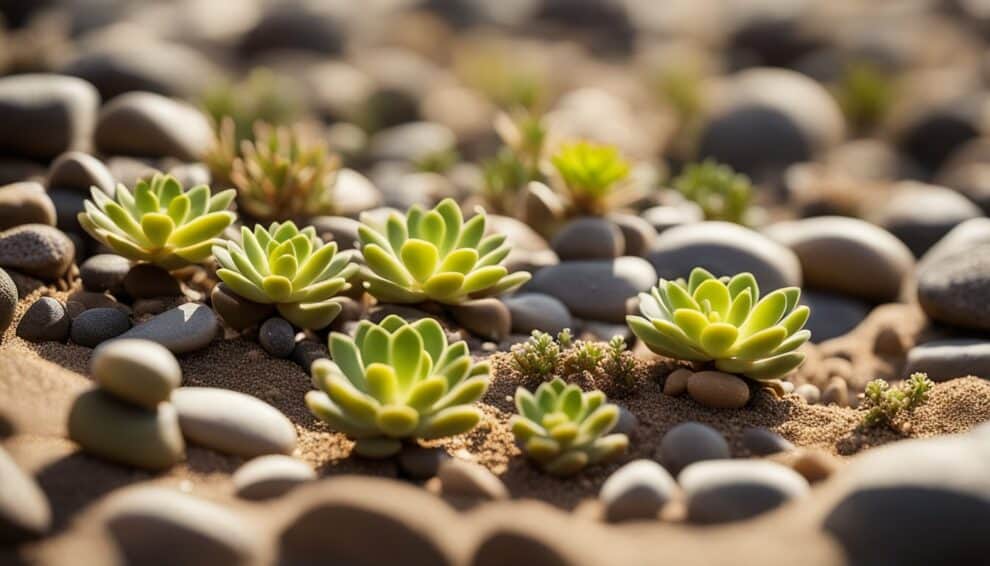Lithops spp., commonly known as living stones, are fascinating and unique succulents that have gained popularity among plant enthusiasts.
These plants are native to South Africa and are known for their ability to camouflage themselves in their natural habitat, making them look like stones.
Due to their unusual appearance and low maintenance, they have become a favorite among beginner gardeners.

In this article, we will explore the world of Lithops spp. and provide tips on how to care for these living stones.
We will cover the basics of their natural habitat, their unique physical features, and the best practices for growing them indoors.
Whether you are a curious beginner or an experienced gardener looking to add some variety to your collection, this article will provide valuable insights into the world of Lithops spp.
Understanding Lithops
What Are Lithops?
Lithops, commonly known as living stones, are a type of succulent plant native to Southern Africa.
They are known for their unique appearance, resembling small rocks or stones.
Lithops come in various colors such as green, brown, grey, and even pinkish, and their leaves are fused together to form a pair of thick, fleshy, and almost translucent leaves.
Lithops are fascinating plants because they have evolved to mimic their surroundings, allowing them to blend in seamlessly with their environment.
This camouflage helps protect them from predators and harsh weather conditions.
They are also known for their ability to survive in extreme temperatures and low water conditions.
Natural Habitat and History
Lithops are found in the arid regions of Southern Africa, including Namibia, Botswana, and South Africa.
They are commonly found in rocky areas, gravel plains, and sandy soils.
Lithops have been around for millions of years and have adapted to their harsh environment by developing their unique physical characteristics.
Lithops were first discovered by William John Burchell, a British explorer, in 1811.
However, it wasn’t until the 1930s that they became popular as houseplants.
Today, they are a sought-after plant for collectors and beginners alike due to their unique appearance and easy care.
In conclusion, Lithops are fascinating plants that have evolved to survive in harsh environments.
Their unique appearance and ability to blend in with their surroundings make them a popular choice among plant enthusiasts.
Understanding their natural habitat and history can help beginners care for these living stones with ease.
Essential Care Guide

Soil and Potting Requirements
Lithops spp. are succulent plants that require well-draining soil to thrive.
It is recommended to use a mixture of equal parts of perlite, sand, and potting soil to create the perfect growing medium.
The potting container should have a drainage hole to prevent waterlogging, which can lead to root rot.
When repotting, it is important to handle the plant with care as the roots are delicate.
Gently loosen the soil around the roots and remove any dead or damaged roots before transplanting into a new container.
Watering Techniques
Lithops spp. are adapted to survive in arid environments and can store water in their leaves for extended periods. Overwatering can be fatal to these plants.
It is recommended to water only when the soil is completely dry, and the leaves appear to be slightly wrinkled.
During the growing season, which is typically from fall to spring, water once every two weeks.
In the dormant season, which is typically from summer to early fall, reduce watering to once a month.
Light and Temperature Needs
Lithops spp. require bright, indirect sunlight to thrive.
They can tolerate direct sunlight, but it is best to avoid exposing them to it for extended periods.
A south-facing window with a sheer curtain is ideal for these plants.
These plants prefer warm temperatures ranging from 65°F to 80°F during the day and 50°F to 55°F at night.
They can tolerate a range of temperatures, but it is important to avoid exposing them to extreme temperature fluctuations.
In summary, Lithops spp. are low-maintenance plants that require well-draining soil, infrequent watering, and bright, indirect sunlight.
By following these essential care guidelines, even a curious beginner can successfully grow and enjoy these fascinating “living stones.”
Propagation and Growth

Seeds vs. Division
Lithops spp. can be propagated by both seeds and division. Seeds are the most common method of propagation.
After the plant has finished flowering, it will produce small, papery capsules containing tiny seeds.
These can be collected and sown in a well-draining soil mix. It is important to keep the soil moist but not waterlogged until the seeds germinate.
Germination can take anywhere from a few days to several weeks, depending on the species and growing conditions.
Division is another method of propagation, but it is not recommended for beginners.
It involves carefully separating the plant into smaller clumps, each with its own set of roots. This can be tricky, as Lithops spp.
have a shallow root system that is easily damaged. Division is best done in the spring, just before the plant enters its active growth phase.
Growth Stages and Timelines
Lithops spp. have a unique growth cycle that is divided into two distinct stages: the active growth phase and the dormant phase.
The active growth phase begins in the fall, when the plant starts to produce new leaves.
During this time, the plant requires regular watering and fertilization to support its growth.
The active growth phase lasts for approximately six months, until the plant enters its dormant phase in the spring.
During the dormant phase, the plant stops growing and goes into a state of rest. It requires very little water and no fertilization during this time.
The dormant phase lasts for approximately six months, until the plant enters its active growth phase again in the fall.
It is important to note that Lithops spp. are slow-growing plants.
They may take several years to reach maturity, depending on the species and growing conditions.
Patience is key when caring for these fascinating living stones.
Troubleshooting Common Issues

Overwatering Symptoms
Lithops are susceptible to root rot if they are overwatered. Signs of overwatering include soft, mushy leaves, and a yellowing or browning of the plant.
If you suspect that your Lithops is overwatered, stop watering it immediately and allow the soil to dry out completely.
It’s important to note that Lithops are adapted to survive drought conditions, so they can go for long periods of time without water.
To prevent overwatering, it’s important to use a well-draining soil mix and to avoid watering the plant during its dormant period.
During the dormant period, which typically lasts from late spring to early fall, Lithops will not require any water at all.
Pest Management
Lithops are generally not prone to pest infestations, but they can occasionally fall victim to mealybugs or spider mites.
Mealybugs are small, white, cottony insects that can be found on the leaves and stems of the plant.
Spider mites are tiny, spider-like insects that can be found on the underside of the leaves.
To control mealybugs, use a cotton swab dipped in rubbing alcohol to wipe the insects off the plant.
For spider mites, use a solution of one part rubbing alcohol to three parts water and spray the plant thoroughly.
Be sure to repeat the treatment every few days until the infestation is under control.
It’s important to note that pesticides should be used as a last resort, as they can be harmful to the plant and to the environment.
If you do use a pesticide, be sure to follow the instructions carefully and to keep the plant away from children and pets.
Frequently Asked Questions

How do I properly water my Lithops to keep them healthy?
Lithops are desert plants and can survive long periods without water. It is important to allow the soil to dry out completely before watering again.
During the growing season, water sparingly once a week or when the leaves start to wrinkle.
In the dormant season, reduce watering to once a month or when the leaves start to shrivel.
Overwatering can cause the plant to rot, so it is important to ensure proper drainage.
Can you tell me the best soil mix for cultivating Lithops?
Lithops prefer well-draining soil with a high mineral content. A mixture of coarse sand, perlite, and gravel is ideal for growing Lithops.
Avoid using regular potting soil, which can retain too much moisture and cause the plant to rot.
What are the growth expectations for Lithops in terms of size?
Lithops are small, slow-growing plants that typically reach a height of 1-2 inches. They grow in clumps and can spread up to 4-6 inches in diameter.
Is there a special way to propagate Lithops effectively?
Lithops can be propagated through seed or by division. To propagate by division, carefully remove the plant from its pot and gently separate the clumps.
Allow the cuttings to dry for a few days before planting in well-draining soil.
Are there any known benefits or uses of Lithops in traditional medicine?
There are no known medicinal uses for Lithops. However, they are popular among collectors and are often used in decorative arrangements.
When do Lithops typically bloom, and what do their flowers look like?
Lithops typically bloom in the fall or winter. The flowers are small and daisy-like, and come in shades of white, yellow, pink, and orange.
The flowers only last for a few days, but are a beautiful addition to the plant’s unique appearance.














